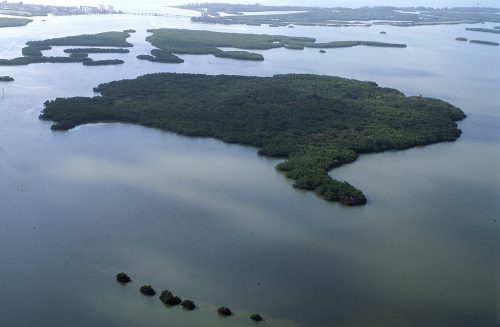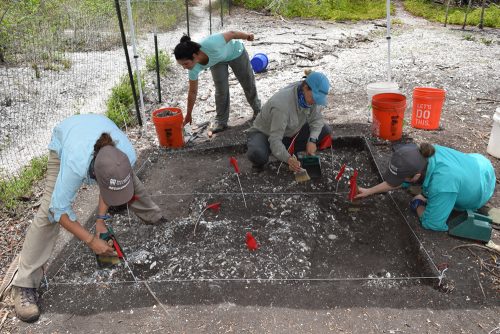Pedro Menéndez de Avilés, appointed by the King of Spain to advance interests in Florida, set foot on Mound Key with a formidable entourage of some 20 officers, 200 soldiers, flag bearers, and musicians.

It was winter, 1566, and Menéndez had been invited to dinner in the palatial home of Calusa King Caalus, the undisputed ruler of South Florida. Pipers played and drummers drummed as the Spaniards marched to the top of a 30-foot-tall hill dominated by a structure that could hold 2,000 people. Menéndez and the officers and musicians entered, but – wary of betrayal – Menéndez ordered his soldiers to remain outside with the fuses of their portable matchlock cannons smoldering.
Outside the palace, 500 young Calusa girls sang joyous songs. Inside, gifts were exchanged and diplomatic speeches were offered. The Calusa brought a sizable feast of fish and shellfish, the Spaniards contributed honey, biscuits, wine, and quince. An uneasy alliance was arranged, and by 1567 a fort and mission known as San Antón de Carlos had been established. Spanish ambitions went unrealized, however, and by June, 1569 they had withdrawn from the island.

Recent work by a team from the Florida Museum, the University of Georgia, Florida Gulf Coast University, and Flagler College has resulted in the identification of the remains of the Calusa king’s house on Mound 1; the site of Fort San Antón de Carlos; and engineered watercourts that served to capture and store fish that supported the Calusa population.
Now, more than 450 years after the Spaniards abandoned their fort and mission, on September 17, 2019, the Lee County Commission voted to buy the last privately owned property on Mound Key, the Calusa capital. The county’s 20/20 conservation program will pay $860,000 for the McGee property, the last 9.5 acres in private ownership. Most of the 113-acre island has been owned by the state since the 1960s.
The parcel contains a substantial portion and the mouth of the great canal; both of the massive water courts; intact ridges above the courts that reveal evidence of mass food preparation during the heyday of the Calusa; a large part of Mound 2— location of the Spanish fort and mission— and waterlogged deposits with preserva- tion of organic materials such as wood, cordage, and netting. Logistically, the parcel is accessible from a sturdy dock built by the McGees, and the ground is free of most vegetation.
Archaeological potential is exceptionally high. The McGee brothers – Ted, Todd, and Tim –carefully preserved the land, leaving artifacts in place on the surface and prohibiting digging in the deposits except by trained professionals. Their parcel has been used as a goat farm for many years, and despite trepidation that the goats would destroy archaeological deposits, quite the opposite is true. The goats eat most of the vegetation on the ground and what they can reach in the trees, but – unlike wild hogs – they do not dig beneath the surface nor cause erosion damage. The result is an open landscape where topography is evident and remote-sensing techniques such as ground-penetrating radar can be employed with ease.
To learn more about ongoing work on Mound Key, look for its Facebook site, or read past articles in this newsletter, available online at Friends of the Randell Research Center Newsletter. The following newsletters contain more on Mound Key: Vol. 13, No. 2; Vol. 14, No. 1; Vol. 15, No. 1; Vol. 15, No. 2; Vol. 16, No. 1; Vol. 16, No. 3.